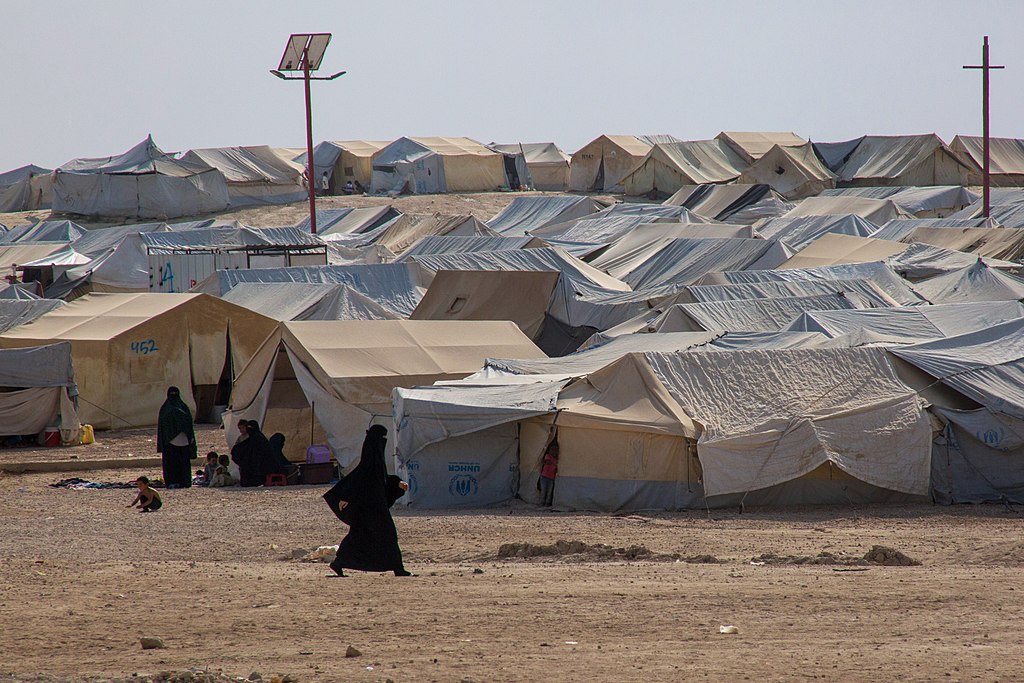
Al-Hawl refugee camp. (2023, February 24). In Wikipedia. https://en.wikipedia.org/wiki/Al-Hawl_refugee_camp
Washington: A top United States military commander today (IST) warned that more than 25,000 children in al-Hol Camp in northeastern Syria could become a prime target of the Islamic State of Iraq and Syria (ISIS) radicalization.
These children were in danger of being indoctrinated. The Commander of the US Central Command, General Michael “Erik” Kurilla, claimed the “horrible” conditions in the camp made them even more susceptible to the ISIS ideology.
With approximately 56,000 residents, more than 90 per cent of them women and children living in tents, the al-Hol Camp is a flashpoint of human suffering. General Kurilla, in a telephonic briefing at the US State Department, suggested that while a short-term goal would be to make the camp safer for all residents and reduce the influence of ISIS on those residents, the long-term goal, however, must be the successful repatriation, rehabilitation, and reintegration of the camp residents back into their country of origin.
“We continue working with the Syrian Democratic Forces to address both, security at the camp as well as the humanitarian conditions. Working together on al-Hol is an extension of our ongoing cooperation to ensure the enduring defeat of ISIS,” he said.
The camp administration, the Syrian Democratic Forces (SDF), and the camp’s security are trying to make the camp safer through increased force protection measures. General Kurilla said the US Central Command (CENTCOM) remains focused on supporting these security forces as they diligently work to improve conditions at the camp. “This is critical to securing the lasting defeat of ISIS. We’re committed to preventing the resurgence of the group.”
The capability of the current generation of ISIS leaders and fighters is significantly degraded in Iraq and Syria. There are roughly 10,000 ISIS fighters in detention camps throughout Syria and approximately 10,000 in Iraq in detention centres. The SDF partners -a coalition of ethnic militias and rebel groups in North and East Syria – secure these camps. However, General Kurilla warned that the group does maintain the capability to conduct operations in the region. “The vile ideology remains uncontained and unconstrained,” he said, adding that he had information that the group has the desire to strike outside of the region. “
There are of late, also speculations as to what extent the Russian-Ukrainian war and the possible Turkish intervention in Syria will affect the US capabilities and its early warning devices and systems to fight ISIS and other terrorist groups in the region.
General Kurilla said he was “very very concerned” about the possibility of a Turkish incursion because that could destabilize the region and call the SDF partners off of the prisons. It also can put at risk security down at al-Hol Camp.
There are about 28 prisons across northern Syria. The General recalled that in January 2022, there was a breakout in one of the prisons of almost 4,000 ISIS detainees. “So anything we can do to de-escalate the situation and prevent that incursion by the Turks would be important,” he said.
Meanwhile, General Kurilla also acknowledged that Iran continues to undermine regional security and stability through militia groups, ballistic missile capabilities, Unmanned Aerial Vehicles, and routine threats to international waterways.
“Iran continues to violate sanctions and embargoes, proliferate weapons to its network of proxies and affiliates, and seize shipping in international waters. Iran continues to spread chaos through violent proxy groups funded by Tehran. And these Iranian-aligned groups routinely strike at American troops and our partners in Iraq and Syria. For more than 40 years, the Iranian regime has funded and aggressively supported terrorism and terrorist organizations and defied international norms by conducting malign activities while destabilizing not only the region but global security and commerce as well,” he said.
The General in particular called Iranian drones a threat in the region. “Iran commands an arsenal of drone systems ranging from small, short-range to modern intelligence, surveillance, and reconnaissance units. They are building larger drones that can fly further with increasingly deadly payloads. We see the UAVs of today in the same way we viewed IEDs during our initial conflicts in Iraq and Afghanistan,” he said.
– global bihari bureau





